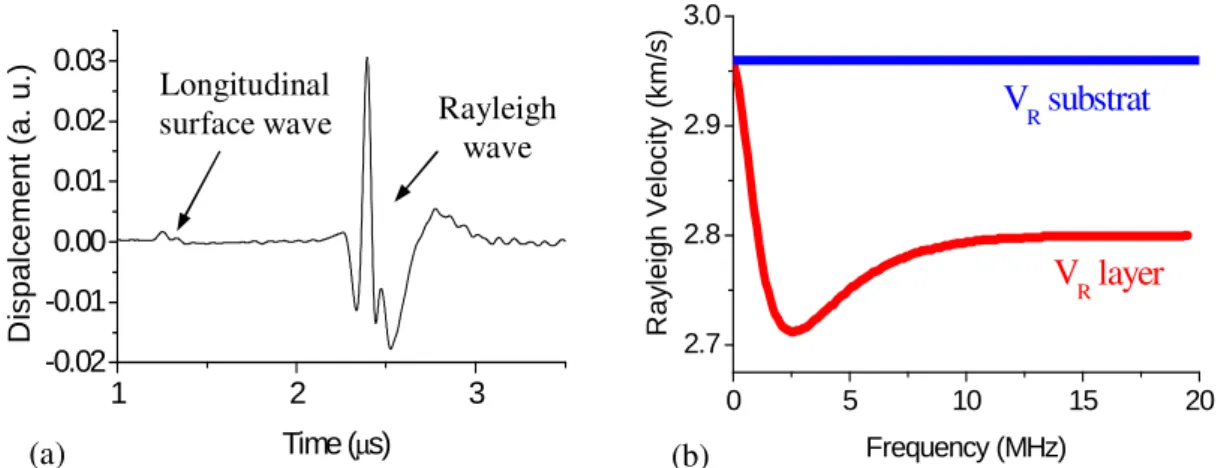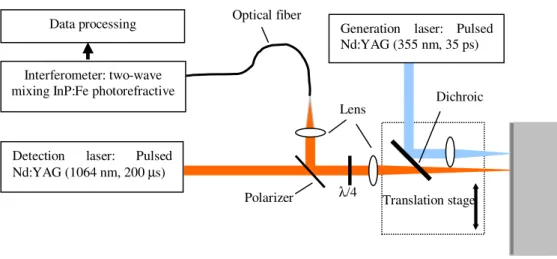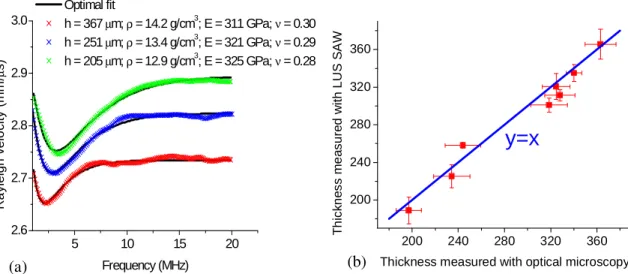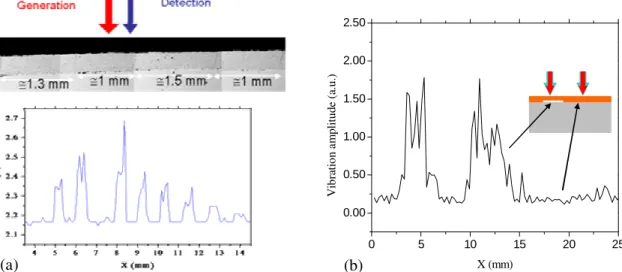Publisher’s version / Version de l'éditeur:
Vous avez des questions? Nous pouvons vous aider. Pour communiquer directement avec un auteur, consultez la première page de la revue dans laquelle son article a été publié afin de trouver ses coordonnées. Si vous n’arrivez pas à les repérer, communiquez avec nous à PublicationsArchive-ArchivesPublications@nrc-cnrc.gc.ca.
Questions? Contact the NRC Publications Archive team at
PublicationsArchive-ArchivesPublications@nrc-cnrc.gc.ca. If you wish to email the authors directly, please see the first page of the publication for their contact information.
https://publications-cnrc.canada.ca/fra/droits
L’accès à ce site Web et l’utilisation de son contenu sont assujettis aux conditions présentées dans le site
LISEZ CES CONDITIONS ATTENTIVEMENT AVANT D’UTILISER CE SITE WEB.
1st International Symposium on Laser-Ultrasonics: Science, Technology and Applications [Proceedings], pp. 1-6, 2008
READ THESE TERMS AND CONDITIONS CAREFULLY BEFORE USING THIS WEBSITE.
https://nrc-publications.canada.ca/eng/copyright
NRC Publications Archive Record / Notice des Archives des publications du CNRC :
https://nrc-publications.canada.ca/eng/view/object/?id=e246ed84-8124-4129-8e0a-329e56c48fb3 https://publications-cnrc.canada.ca/fra/voir/objet/?id=e246ed84-8124-4129-8e0a-329e56c48fb3
NRC Publications Archive
Archives des publications du CNRC
This publication could be one of several versions: author’s original, accepted manuscript or the publisher’s version. / La version de cette publication peut être l’une des suivantes : la version prépublication de l’auteur, la version acceptée du manuscrit ou la version de l’éditeur.
Access and use of this website and the material on it are subject to the Terms and Conditions set forth at
Laser-Ultrasonic Evaluation of Thermal Spray Coatings
Krüger, Silvio; Lesvesque, Daniel; Bescond, Christophe; Lima, Rogerio; Maple, Basil; Campagne, Benjamin; Blouin, Alain; Monchalin, Jean-Pierre
Laser-Ultrasonic Evaluation of Thermal Spray Coatings
Silvio KRUGER, Daniel LÉVESQUE, Christophe BESCOND, Rogerio LIMA, Basil MAPLE, Benjamin CAMPAGNE, Alain BLOUIN and Jean-Pierre MONCHALIN
Industrial Materials Institute, National Research Council of Canada Boucherville, Québec, Canada; Phone: +1 450 641 5076, Fax +1 450 641 5106;
silvio.kruger@cnrc-nrc.gc.ca
Abstract
The non-destructive characterization of thermal spray coatings for thermal barriers, wear or anti-corrosion coatings is of particular importance for quality control, but it can be also very useful for understanding the mechanical and thermo-mechanical behavior of parts allowing the development of life prediction models. Laser-ultrasonics, a non-contact technique with great flexibility for generation and detection spot geometry, presents many advantages over conventional ultrasonic techniques for this application. In this paper, some recent works on the characterization of thermal sprayed coatings by laser-ultrasonics are presented. First, the use of surface acoustic waves to obtain elastic properties, density and thickness of dense coatings is considered and results obtained with WC-Co coatings are presented. Second, elastic property measurements on thermal barrier coatings are introduced and, finally, results on the detection of defects like vertical cracks and coating disbonding for dense coatings are discussed. Keywords: Laser ultrasound, coating, thermal spray, WC-Co, surface acoustic waves
1. Introduction
Thermal sprayed coatings have been widely used to improve materials performance by providing them outstanding properties like corrosion protection, wear protection or thermal insulation. Because of their special lamellar structure, inhomogeneous composition and the presence of discontinuities like pores and cracks, the elastic properties of thermal sprayed coatings are significantly different from those measured in the same bulk materials processed by other means, and may vary with the spray conditions employed for deposition. If the assessment of coating properties is done in a non-destructive way, it provides a powerful quality control tool, since these properties should be directly related to the desired technological performance characteristics like wear behavior and fatigue life.
The ultrasonic waves propagate through the thickness of the coating (bulk waves) or along the coating (surface waves). Surface waves have been used largely for characterization of coatings due to their sensitivity to many properties [1]. Among the advantages of the laser-ultrasonic technique compared to conventional ultrasonics, are its non-contact character (it can be applied on hot and moving materials), the ease of changing the generation and detection spot geometries according to the type of wave to be measured, the large bandwidth of signals, and the absence of a coupling medium such as water that could give rise to erroneous measurements on porous coatings.
2. Characterization of WC-Co coatings
Thermal spraying of WC-Co presents a cost-effective solution for depositing coatings to reduce wear and corrosion. High velocity oxy-fuel (HVOF) thermal spray WC-Co
coatings are also an excellent replacement for hard chromium electroplating. In this section, it is introduced WC-Co coatings characterization by solving an inverse problem with an optimization procedure to minimize the difference between the measured and calculated Rayleigh wave dispersion curves. This concept has already been used, with some degree of success, for the characterization of thermal sprayed coatings [2] and other coatings [3]. A broader review of previous works can be found in Ref. 4.
Laser-ultrasonics allows generation and detection of surface waves of both longitudinal (sometimes called surface skimming longitudinal wave (SSLW) or P-wave) and Rayleigh modes as shown in Figure 1a. The Rayleigh wave amplitude decreases with depth and this decrease depends on the wavelength (or frequency). Long wavelengths (low frequency) penetrate deeper in the material while shorter wavelengths (high frequency) propagate closer to the surface, making this technique very attractive for characterizing materials with depth dependent properties like coatings.
The velocity dispersion of Rayleigh waves propagating in a coated material can be calculated if the thickness, elastic constants and density of both coating and substrate are known. Figure 1b shows a curve calculated with values expected for a WC-Co coating on a steel substrate. The Rayleigh velocity dispersion curve tends to the Rayleigh velocity in steel at low frequency and to the Rayleigh velocity in WC-Co at high frequency. Note that this dispersion curve presents a minimum at intermediate frequencies. This minimum comes from the important difference between the density value of the WC-Co coating and that of the steel substrate.
1 2 3 -0.02 -0.01 0.00 0.01 0.02 0.03 D is pal c e m ent ( a . u.) Time (µs) 0 5 10 15 20 2.7 2.8 2.9 3.0 VR layer R a y le ig h V e lo c it y ( k m /s ) Frequency (MHz) VR substrat
Figure 1. (a) Typical experimental signal of surface acoustic waves obtained in a WC-Co coating and (b) Rayleigh velocity dispersion as calculated by a model for a WC-Co coating on a steel substrate. Simulations shows that changes of the dispersion curve due to the coating thickness and density are readily recognizable, but the measure of two independent elastic constants is not robust as different combinations of Young’s modulus and shear modulus can result in similar dispersion curves. Fortunately, laser-ultrasonics also produces a longitudinal mode propagating near the surface as shown in the signal measured on a WC-Co coating in Figure 1a. When propagating only or mostly in the coating, it can provide an independent measure that, combined with the Rayleigh wave, will result in a full and robust characterization of elastic properties of an isotropic material.
Longitudinal
surface wave Rayleigh
wave
Eight samples were obtained by variation of the processing parameters. The WC-12%Co agglomerated and sintered feedstock was deposited by HVOF on low-carbon steel substrates. The thicknesses of the samples were measured by optical microscopy of cross-sectioned samples and are in the range of 190 to 360 µm. The porosity was found to be below 1% for all samples. The laser-ultrasonic experimental set-up is presented in Figure 2. A pulsed Nd:YAG laser (3rd harmonic: 355 nm wavelength, 35 ps pulse duration) is employed to generate a Rayleigh wave in the ablation regime. For the detection, a long-pulsed Nd:YAG laser (1064 nm wavelength, 200 µs pulse duration) is coupled to an InP:Fe photorefractive interferometer [5] by optical fibers. This photorefractive interferometer provides good sensitivity on unpolished surfaces and good response to lower ultrasonic frequencies. A line-source and line-detection configuration is used with line dimensions of about 10 mm long by 50 µm wide for both the generation and detection.
Figure 2. The laser-ultrasonic setup.
In Figure 3a, the inverse problem results are shown for three of these samples, where the squares, circles and triangles are the experimental data and the solid lines are the Rayleigh velocity dispersion curves calculated with the optimal values. The thickness, the density, the Young’s modulus and the Poisson’s ratio found with the technique are indicated in the figure. In Figure 3b, the thicknesses measured with laser-ultrasonics and with an optical microscope after sectioning the sample are compared. The straight line indicates the case of a perfect correlation between the two thickness measurements. It is observed that the data points are well along the straight line, thus indicating an excellent correlation. Note that, for such coatings, the thickness is not perfectly uniform and their variations observed by optical microscopy are indicated by the error bars representing plus or minus one standard deviation. The error bars for the laser-ultrasonic measures are obtained from the variations with different propagation distances.
The coating of one of the eight samples was separated from the substrate for further measurements. Its density, as measured by Archimedes’s method, was found to be 13.4 g/cm3, which is very close to the value of 13.5 g/cm3 obtained by laser-ultrasonics. The Young’s modulus was measured for this sample by a three-point bending test and found to be 318 GPa with an estimated accuracy of ±10%. This is somewhat different than the value of 300 GPa found by laser-ultrasonics, but well within the measurement error of
Detection laser: Pulsed Nd:YAG (1064 nm, 200 µs)
Interferometer: two-wave mixing InP:Fe photorefractive
Translation stage
Sample Generation laser: Pulsed
Nd:YAG (355 nm, 35 ps) Optical fiber λ/4 Polarizer Dichroic Lens Data processing
such a bending test. The precision on the Young’s modulus of the proposed laser-ultrasonic method estimated from different propagation distances is about 2%. This accuracy could not be verified by an independent method due to the intrinsic inaccuracy of available techniques.
Figure 3. (a) Example of optimization results, where the symbols represent experimentally obtained velocity dispersion and the solid lines are the optimal fitting curves from the model. (b) Thickness
obtained by laser-ultrasonics (LUS) compared to that obtained by optical microscopy.
3. Elastic property measurements on thermal barrier coatings
Thermal sprayed barrier coatings (TBCs) are widely used in gas turbine components and have always exhibited an important challenge to their ultrasonic nondestructive characterization. The thermal barrier properties come from the network of cracks and voids that create barriers to heat propagation. As the cracks are not randomly oriented, the properties of thermal barrier coatings are in most cases very anisotropic. It is common to assume the anisotropic symmetry of TBCs as transversely isotropic (analog to hexagonal structure), where the elastic constants in the plane (axes 1 and 2) of the coating are independent of direction but different from the properties in the direction perpendicular to the coating surface (axis 3). The results presented in this section are limited to the in-plane (C11) and through-thickness (C33) elastic constants.
Commercially available 8 wt% yttria-stabilized zirconia powder was thermal sprayed on a steel substrate with a plasma torch using a wide range of spray parameter settings. The tested samples were produced for a study of the effect of some projection parameters on the final properties of TBCs, and more details can be found in Ref. 6. The laser-ultrasonic measurements of surface acoustic waves were done in the configuration shown in Figure 2, and the through-thickness measurements were done in a transmission configuration where the ultrasonic waves are generated on the coating and detected on the opposite substrate surface. To obtain a simple elastic constant in the through-thickness and in-plane directions, only the arrival of the first echo in each waveform is measured. The elastic constants are calculated from the measured velocities assuming a fixed value of the density of 4.7 g/cm3.
200 240 280 320 360 200 240 280 320 360 T h ic k n e s s m e a s u re d w it h L U S S A W
Thickness measured with optical microscopy
y=x
5 10 15 20 2.6 2.7 2.8 2.9 3.0 Optimal fit h = 367 µm; ρ = 14.2 g/cm3; E = 311 GPa; ν = 0.30 h = 251 µm; ρ = 13.4 g/cm3; E = 321 GPa; ν = 0.29 h = 205 µm; ρ = 12.9 g/cm3; E = 325 GPa; ν = 0.28 R a y le ig h v e lo c it y ( m m / µ s ) Frequency (MHz) (a) (b)Figure 4 shows the through-thickness versus in-plane elastic constants measured in many samples produced with different processing conditions and various thermal treatments. The strong correlation between the elastic constants obtained in the two directions is very clear, suggesting that even if five elastic constants are necessary to fully characterize this anisotropic coating, the measurement of only one constant could provide a good indication of the other elastic constants of the coating.
Figure 4. Through-thickness versus in-plane thermal barrier elastic moduli for various processing conditions and heat treatments (as sprayed and heat treated for 1, 5 and 20 hours at 1400 ºC).
4. Detection of cracks and disbonding in WC-Co coatings
Another important aspect of the non-destructive evaluation of coatings is the detection and sizing of discontinuities. A thermal sprayed WC-Co coating sample with vertical cracks (Figure 5a) was scanned with laser generation and detection spots separated by about 0.5 mm. The laser-ultrasonic configuration is essentially the same as that of Figure 2.. The presence of the crack will block the propagation of the surface acoustic waves. The measurement of a waveform parameter like the amplitude of the Rayleigh wave, can easily identify the zones with and without cracks. Figure 5a shows the variations of a waveform parameter along a sample, and the distance between the peaks is found to be the same as the distance between cracks measured by metallography in the sample cross section.
Also, if there is a complete disbonding between the coating and the substrate, the coating when excited by the generation laser will vibrate like a membrane. This vibration can be readily detected with a system responding at sufficiently low frequencies [7]. Signals obtained on a WC-Co coating in a region where there is good adhesion show clear differences from signals of a region where the coating is detached. In the tested sample, there were large oscillations at about 200 kHz on the signals of the detached area. Figure 5b shows a plot of the vibration amplitude over a line scan taken in a region where the coating is partially detached from the substrate. The regions with disbonding can be readily distinguished.
Generation
Detection Generation
laser beam laser beam Detection
d 0 50 100 150 200 250 0 50 100 150 200 250 E, in-plane (GPa) E , th ro u g h t h ic k n e s s ( G P a ) As Sprayed 1h 5h 20h
Figure 5. Laser-ultrasonic detection of cracks in WC-Co coatings. (a) Cross-sectional view of a sample with the generation/detection scheme, and variation of a waveform parameter along the sample. (b) Profile of the vibration amplitude in a region where the coating is partially detached from the substrate.
5. Conclusion
The laser-ultrasonic technique presents many advantages over conventional ultrasonics for thermal spray coating characterization. First of all, it is a fully non-contact technique, eliminating all the inconveniences of direct-contact or immersion techniques. Another major advantage is its easy control of the generation and detection laser spots that provides a powerful flexibility to efficiently generate and detect different wave modes, like surface acoustic waves. The technique also provides unmatched broadband and meaningful sensitivity if sufficiently powerful lasers are used. The limitations of the technique are mainly related to its complexity and cost, while the laser security and surface damage can be a challenge for some applications. The examples presented in this paper show that laser-ultrasonics can provide outstanding performance for different problems of non-destructive characterization of coatings.
References
1. G. W. Farnell and E. L. Adler, Physical Acoustics, Academic Press, New York, Vol 2, 1972.
2. A. Abbate, W. Russell, J. Goldman, P. Kotidis and C. C. Berndt, ‘Nondestructive Determination of Thickness and Elastic Modulus of Plasma Spray Coatings Using Laser Ultrasonics’ Rev. of Progr. in
Quant. Nondestr. Eval., Thompson and Chimenti, eds., Vol. 18, Plenum, NY, pp. 373-380, 1999.
3. D. Schneider and T. Schwarz, ‘A Photoacoustic Method for Characterising Thin Films’ Surf. and
Coat. Technol. Vol 91, pp 136-146, 1997.
4. C. Bescond, S. E. Kruger, D. Lévesque, R. S. Lima, and B. R. Marple ‘In-Situ Simultaneous Measurement of Thickness, Elastic Moduli and Density of Thermal Sprayed WC-Co Coatings by Laser-Ultrasonics’ Journal of Thermal Spray Technology, 16, 2007, pp. 238-244.
5. P. Delaye, A. Blouin, D. Drolet, L.-A. de Montmorillon, G. Roosen and J.-P. Monchalin, ‘Detection of ultrasonic motion of scattering surface by photorefractive InP:Fe under an applied dc field’ J. Opt.
Soc. Am. B, Vol 14, 1997, pp. 1723-1734
6. B. R. Marple, R. S. Lima, C. Moreau, S. E. Kruger, L. Xie, M. Dorfman, ‘Processing and Properties of Yttria-Stabilized Zirconia TBCs Produced Using Nitrogen as Primary Plasma Gas’ Thermal Spray 2007, Ed by. B.R. Marple et al, ASM International®, Materials Park, Ohio, USA, pp. 405-410, 2007. 7. A. Blouin, B. Campagne, C Néron and J.-P. Monchalin, ‘Detection of Skin Disbond in Honeycombs
and Coating Detachment by Laser Acoustic Technique’ Rev. of Progr. in Quant. Nondestr. Eval, D.O. Thompson and D.E. Chimenti, Eds. Vol 26, API, pp 1140-1147, 2007.
(a) 0 5 10 15 20 25 0.00 0.50 1.00 1.50 2.00 2.50 V ib ra tio n am pl itu de ( a. u. ) X (mm) (b)




